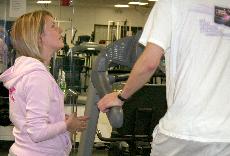Athletic training majors gain valuable experience on, off field

April 4, 2007
There are 18 NCAA Division III teams at Simpson College, and they all have one thing in common. Each home game, meet, or event that they participate in will have a certified athletic trainer there, with at least one student athletic trainer by their side.
During away games, there are also student athletic trainers who travel with the athletes.
The athletic training program is a lot more than just taping ankles and getting ice for the athletes, according to Mike Hadden, program director of athletic training and exercise science.
“We’ve had to explain that athletic training programs are not service-driven entities anymore,” Hadden said. “The days of just taping athletes and getting ice are over. Although those are still components of what we do, there is a great deal of time spent out of classroom that is devoted to the assessment of competencies and clinical proficiencies. Many people don’t realize that. They think all we do is wait around for an injury to happen.”
Hadden came to Simpson in 1997 and said that the program has seen nearly 350 percent growth. At this point, the program has pretty much stabilized in terms of enrollment.
Sophomore athletic training student Katie Larsen really likes the way the athletic training program is set up.
“I like the set up of the program where we are allowed to do three rotations our sophomore year before we spend an entire season with a team,” Larsen said. “It allows us the opportunity to gain more experience with different sports and injuries. It is nice to still be under the supervision of older students and the certified athletic trainers before we are responsible for a team ourselves.”
The student athletic trainers have many duties assigned to them throughout their four years at Simpson. Junior athletic training student Beth Nelson agrees with Hadden that there is a lot more to the major than most people think.
“As a student trainer, it is my job to do everything from evaluating injuries to filling water bottles,” Nelson said. “We basically do anything that has to do with the athlete’s well-being, whether it is due to something that happened on or off the field or court.”
Larsen explained the same duties as Nelson and went on to describe additional responsibilities.
“(We are also responsible for) attending practices and games in case of injury, communicating to the coaches the status of a player’s injury, proper documentation and progress notes of an injury or condition, promote the athletic training profession and be a positive representation of the SC program,” Larsen said.
Many of the athletic training students will continue their education at some sort of graduate program.
“This is not because their education here is sub-optimal, but in order to be competitive in any healthcare field, one has to be as marketable as possible,” Hadden said. “We’ve had students who have gone onto physical therapy, personal training, physician’s assistant, colleges, clinics and high schools.”
Junior athletic training student Emily Nelson fits in to the category Hadden is talking about.
“I am going to go to physical therapy school,” Emily Nelson said. “I hope to still practice athletic training while I am in school and also a little after I get out of PT school. Eventually I will probably just do physical therapy because of the hours since I hope to have a family.”
The group of student trainers and the certified trainers work very closely together throughout the students’ time at Simpson.
“I like the interaction that we get between the trainers and athletes,” Emily Nelson said. “All of our professors really care about us and our academics, so it is nice to know someone cares and will do anything to help you.”
Hadden also likes the relationships he forms with the students and athletes.
“There’s a quote I have hanging in my office that states, ‘Your athletes don’t care how much you know until they know how much you care,'” Hadden said. “I enjoy the interaction I have with the athletes here in the training room and in the classroom. There’s nothing like seeing my students practicing and utilizing the skills they’ve been taught and seeing an athlete come back after rehabilitating an injury.”











